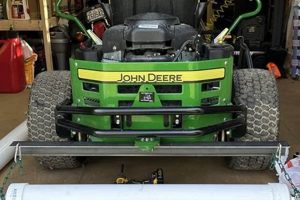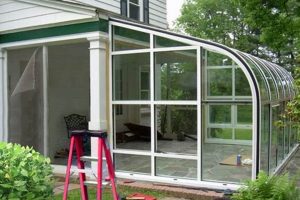An assemblage of materials and instructions designed for the construction of a decorative and sonorous outdoor ornament, a typical package includes components such as tubes, string, a suspension platform, and a striker. These curated collections enable individuals to create personalized sound art, suitable for gardens, patios, or balconies.
The appeal of constructing these handcrafted pieces lies in the blend of creative expression and functional outdoor decor. Historically, wind-activated musical instruments have held cultural significance across various societies, symbolizing tranquility and harmony. Creating one offers a tangible connection to these traditions, alongside the satisfaction of producing a unique object. The activity provides relaxation and stress relief.
Subsequent sections will delve into considerations for selecting quality components, explore various design options, and provide guidance on assembly techniques to ensure a resonant and visually appealing final product.
Essential Guidance for Wind Chime Construction
The following guidelines offer insights to maximize the potential of a do-it-yourself sound sculpture project, ensuring longevity, tonal quality, and aesthetic appeal.
Tip 1: Material Selection: Prioritize weather-resistant components. Metal tubes should be aluminum, copper, or stainless steel to prevent corrosion. Wood elements require treatment with sealant or varnish.
Tip 2: Suspension Cord Quality: Utilize high-strength, UV-resistant cord. Nylon or polyester options are preferable, mitigating fraying and breakage due to sun exposure.
Tip 3: Tube Length and Tuning: Carefully calculate the lengths of the tubes to achieve the desired tonal harmony. Online calculators or musical instrument resources can aid in determining precise measurements.
Tip 4: Striker Placement and Material: Position the striker equidistant from the tubes. The material of the striker significantly affects the timbre; consider glass, stone, or metal for varying acoustic qualities.
Tip 5: Secure Knot Tying: Employ reliable knot-tying techniques. The square knot and the fisherman’s knot are commonly used for their strength and stability in outdoor conditions. Regularly inspect the knots for signs of wear.
Tip 6: Balancing and Adjustment: Before final assembly, test the balance of the wind chime. Uneven weight distribution can impede movement and produce dissonant sounds. Make incremental adjustments to the hanging points.
Tip 7: Location Consideration: Select a location with adequate exposure to wind. Sheltered areas may inhibit activation, while excessively windy locations may cause damage.
Adhering to these principles allows for the creation of a durable and aesthetically pleasing outdoor art object, providing both visual and auditory enhancement.
The final segment will explore methods for maintaining and repairing the finished creation, extending its lifespan and preserving its acoustic qualities.
1. Component Material Quality
The integrity and longevity of a wind chime are inextricably linked to the quality of materials used in its construction. The selection of appropriate components directly influences the instrument’s ability to withstand environmental stressors and maintain its acoustic properties over time. A substandard material choice can lead to premature degradation, impacting both the visual appeal and the sonic characteristics of the finished piece.
- Corrosion Resistance
The selection of metals resistant to oxidation is critical. Aluminum, stainless steel, and copper are frequently utilized for tubes and strikers due to their inherent resistance to rust. Utilizing untreated steel will lead to rapid deterioration and failure. Consider the salinity of the environment. Proximity to coastal areas necessitates materials with enhanced resistance to salt corrosion.
- UV Stability of Suspension Cord
The suspension cord experiences constant exposure to ultraviolet radiation, which can degrade the material over time. Nylon or polyester cords, specifically formulated to resist UV damage, are essential. Natural fibers such as cotton or hemp are unsuitable due to their rapid decomposition when exposed to sunlight and moisture.
- Weather Treatment of Wood Components
If the design incorporates wooden elements, thorough treatment with sealant or varnish is mandatory. This protects the wood from moisture absorption, preventing warping, cracking, and fungal growth. Untreated wood will quickly deteriorate, compromising the structural integrity of the design.
- Durability of Striker Material
The striker material must withstand repeated impacts without fracturing or chipping. Hardwoods, glass, or certain types of stone are commonly employed. Brittle materials, such as low-quality plastics or soft stones, will exhibit accelerated wear and require frequent replacement.
The cumulative effect of these material choices directly impacts the overall lifespan and acoustic quality. A considered approach to component material selection ensures a durable and aesthetically pleasing outdoor instrument, capable of withstanding the elements and providing years of enjoyment.
2. Acoustic Properties
The sonic characteristics of a wind chime are a direct result of its acoustic properties, dictated by the materials, dimensions, and arrangement of its components. Tube length, diameter, wall thickness, and composition significantly influence the frequencies produced when struck. Shorter tubes generate higher-pitched tones, while longer tubes produce lower tones. The striker material, whether metal, glass, or wood, also contributes to the timbre of the sound. Inadequate attention to these parameters can result in a dissonant or muted outcome, negating the desired auditory effect. For example, tubes of inconsistent length within the same kit will produce an unharmonious arrangement of tones, demonstrating the importance of precise dimensional control for creating pleasing sounds.
The practical application of acoustic principles within a do-it-yourself project involves careful selection and measurement. A typical process involves calculating the resonant frequency of each tube, based on its length and material properties. A pre-packaged assortment failing to offer properly tuned tubes will result in an unsatisfactory musical outcome. Utilizing online resources and calculators provides guidance to achieve specific musical scales or harmonies. The strategic positioning of the striker is also vital; incorrect placement dampens vibration and alters the intended tone. This demonstrates the essential nature of proper assembly practices to achieve desired acoustic characteristics.
In summary, the acoustic properties are fund
amental to the success of constructing a wind chime. Achieving the intended sound requires a thorough understanding of materials science, frequency relationships, and precise assembly. Lack of consideration of these factors results in a diminished aesthetic and auditory experience. The challenges in replicating professional results underscore the importance of quality materials, precise tuning, and the careful execution of acoustic principles. The outcome provides a direct illustration of the link between physical attributes and sonic phenomena.
3. Assembly Precision
Assembly precision directly influences the structural integrity and sonic quality of a wind chime constructed from a curated collection of components. Incorrect assembly can lead to compromised sound production, premature component failure, and a diminished aesthetic presentation. The components must be joined with accuracy and care to ensure the chime operates as intended. For instance, tubes suspended at uneven lengths will produce dissonant tones and may collide, affecting the instrument’s overall auditory experience. Similarly, improperly secured knots can unravel, resulting in the detachment of components and rendering the creation unusable.
The practical significance of assembly precision extends to the longevity of the finished product. Securely fastened connections resist the forces of wind and weather, prolonging the instrument’s lifespan. Attention to detail during construction, such as ensuring proper alignment and spacing of tubes, contributes to a balanced and harmonious sound. Furthermore, the aesthetic appeal is enhanced by careful assembly, showcasing craftsmanship and attention to detail. A real-world example can be observed in mass-produced wind chimes lacking precise assembly, which often exhibit poor sound quality and a short service life, reinforcing the need for stringent assembly control.
In summary, assembly precision is a critical factor in the successful construction of a wind chime. The quality of the finished product is intrinsically linked to the accuracy and care taken during the assembly process. Compromised assembly leads to reduced lifespan, suboptimal sound, and a diminished visual presentation, emphasizing the need for meticulous execution and adherence to instructions provided with the component collection. The interconnectedness between assembly quality and the finished product’s overall integrity underscores the importance of this factor.
4. Design Customization
Design customization offers a spectrum of possibilities within the creation of a personalized sound sculpture, significantly enhancing the appeal of a curated set of materials. It allows individuals to transform standardized components into unique artistic expressions, reflecting personal preferences and aesthetic sensibilities. The extent of customization directly impacts the final product’s visual and auditory characteristics.
- Material Substitution and Combination
Beyond the standard components, individuals can introduce alternative materials to alter the sound and visual appearance. Substituting metal tubes with bamboo, incorporating glass beads, or utilizing found objects are common examples. These substitutions can create distinct tonal qualities and aesthetic accents, deviating from the conventional sound signature. An individual constructing a nautical-themed piece may incorporate seashells or driftwood, illustrating the integration of personal elements.
- Dimensional Alterations
Modifying the length of the tubes beyond the suggested dimensions allows for the creation of unique tonal scales and harmonies. Altering the tube diameter or wall thickness influences the resonance and sustain of the notes produced. A project involving the precise calculation of tube lengths to match a specific musical key exemplifies this aspect. These dimensional alterations require a deliberate approach, often involving calculations and experimentation to achieve the desired auditory output.
- Aesthetic Embellishments
Applying decorative finishes to the components enhances the visual appeal and allows for further personalization. Painting, staining, etching, or applying decorative wraps transforms the components into personalized works of art. The application of intricate patterns or culturally relevant symbols can infuse the piece with individual meaning. A design featuring hand-painted mandalas or etched patterns showcases the potential for aesthetic enrichment.
- Structural Reconfiguration
Deviating from the standard assembly instructions to alter the overall structure allows for innovative designs beyond conventional linear or circular arrangements. Incorporating asymmetrical layouts, cascading tiers, or kinetic elements creates visually dynamic pieces. For example, a design featuring a spiraling arrangement of tubes suspended from a central point showcases structural ingenuity. These reconfigurations require careful planning and engineering to ensure structural stability and balanced sound distribution.
The incorporation of these design customization techniques transforms a standardized set of components into a unique and expressive art object. These approaches allow for the infusion of personal creativity, resulting in a final product that reflects individual taste and aesthetic preferences, therefore emphasizing the value of personalization.
5. Weather Resistance
Weather resistance constitutes a critical attribute of any outdoor ornament, especially those constructed from do-it-yourself component collections. The ability to withstand environmental stressors directly correlates with the longevity and aesthetic appeal of the finished item. Component selection, construction methods, and protective measures are all essential considerations.
- Material Selection for Longevity
The selection of materials fundamentally impacts weather resistance. Components made from corrosion-resistant metals such as aluminum, stainless steel, or copper exhibit superior performance in humid or marine environments compared to untreated ferrous metals. Similarly, the selection of UV-resistant suspension cords is essential to prevent degradation from prolonged sun exposure. Inappropriate material choices can lead to premature failure and necessitate frequent replacements, thereby increasing the long-term cost of ownership.
- Protective Coatings and Finishes
The application of protective coatings and finishes enhances the ability to withstand weather-related damage. Sealants, varnishes, and paints designed for outdoor use protect wooden components from moisture absorption, preventing warping, cracking, and fungal growth. Similarly, applying a clear coat to metallic components provides an additional barrier against corrosion. The selection of appropriate coatings necessitates consideration of the local climate and the specific properties of the underlying materials.
- Structural Design and Wind Load
The structural design influences the ability to withstand wind load. Aerodynamic designs minimize resistance to wind forces, reducing the ris
k of damage or detachment. Securely fastening components and reinforcing joints are essential for maintaining structural integrity in high-wind environments. Careful consideration of the location and surrounding structures also contributes to reducing wind-related stress. An unstable or poorly designed piece is susceptible to damage during inclement weather, emphasizing the importance of robust engineering. - Maintenance and Inspection Practices
Regular maintenance and inspection practices prolong the lifespan and ensure continued weather resistance. Periodic cleaning removes dirt, debris, and corrosive elements that can accelerate material degradation. Inspecting suspension cords, joints, and finishes for signs of wear or damage allows for timely repairs, preventing further deterioration. Implementing a proactive maintenance schedule significantly enhances the weather resistance and extends the service life.
In conclusion, weather resistance is a multifaceted attribute that requires careful consideration throughout the entire construction process. Component selection, protective measures, structural design, and maintenance practices collectively determine the ability of a creation to withstand environmental stressors and maintain its aesthetic and functional integrity over time. Prioritizing weather resistance ensures a durable and aesthetically pleasing outdoor ornament, providing enduring enjoyment.
Frequently Asked Questions
The following questions address common inquiries regarding the assembly, usage, and maintenance of a curated assemblage of materials intended for crafting an exterior decorative musical instrument.
Question 1: What distinguishes a superior collection of components from a substandard one?
The quality of constituent materials dictates the overall value. Premium selections incorporate corrosion-resistant metals, UV-stable suspension cords, and weather-treated wooden elements. Substandard sets often employ inferior materials that exhibit accelerated degradation under environmental exposure.
Question 2: Is specialized expertise required for successful completion?
No, the assembly is designed for individuals with minimal prior experience. However, familiarity with basic knot-tying techniques and a capacity to follow detailed instructions are advantageous.
Question 3: How are tonal qualities optimized?
Optimal tonal qualities are achieved through precise tube length calculation, strategic striker placement, and adherence to recommended assembly procedures. Tuning tools and online resources are available to assist in achieving specific musical scales or harmonies.
Question 4: What measures ensure prolonged lifespan?
Prolonged lifespan is ensured through the implementation of preventive measures, including periodic cleaning, inspection of suspension cords, and application of protective coatings to wooden elements. Prompt replacement of worn or damaged components mitigates further deterioration.
Question 5: Can the basic structure be modified?
Yes, modification is permissible, but alterations must be approached with caution. Deviations from the recommended design parameters may compromise structural integrity or alter the intended tonal qualities. Careful planning and adherence to sound engineering principles are essential.
Question 6: What safety precautions are essential?
Essential safety precautions include wearing appropriate eye protection during component cutting or drilling. Exercising caution when handling sharp instruments and ensuring a stable working surface minimizes the risk of injury.
In summary, successful utilization requires a commitment to quality materials, adherence to instructions, and a proactive approach to maintenance. Prioritizing these factors ensures a durable, aesthetically pleasing, and sonically harmonious outdoor instrument.
The subsequent article section provides detailed guidance on advanced design techniques and troubleshooting common assembly challenges.
Conclusion
This examination of the “diy wind chime kit” elucidates the multifaceted considerations inherent in its selection, construction, and maintenance. Key aspects include the necessity of high-quality, weather-resistant materials, the importance of acoustic principles in achieving desired tonal characteristics, the impact of assembly precision on structural integrity, the potential for personalized design modifications, and the crucial role of protective measures in ensuring longevity. A comprehensive understanding of these elements enables the creation of a durable and aesthetically pleasing outdoor instrument.
The successful utilization of these curated collections hinges on a commitment to informed decision-making and meticulous execution. By prioritizing quality, precision, and proactive maintenance, individuals can realize the enduring artistic and auditory value inherent in a thoughtfully crafted wind chime, transforming mere materials into a source of lasting sensory enrichment.







